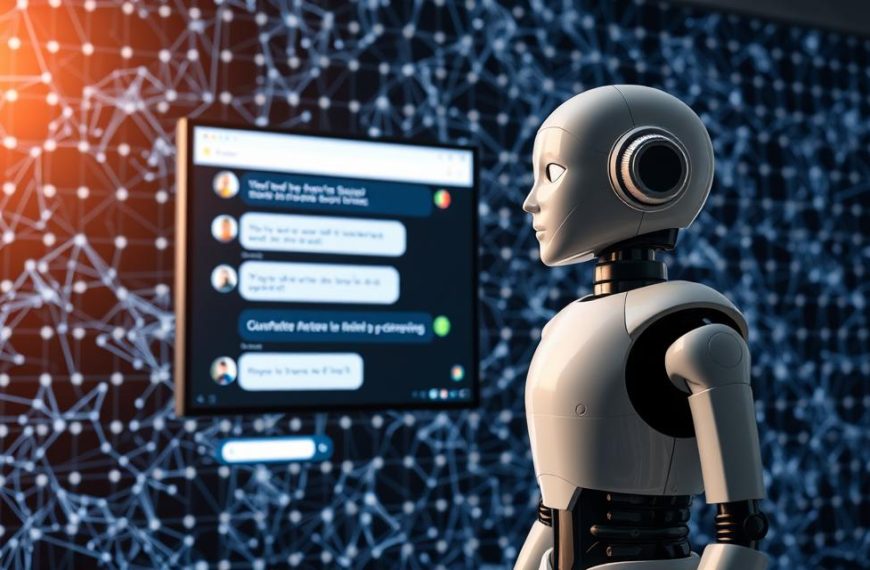Automated chat systems now dominate customer service and business operations worldwide. Recent figures highlight that nearly 1.5 million individuals participated in automated chat interactions last year. This surge reflects a broader shift towards AI-driven solutions in everyday life.
Globally, over 987 million users currently engage with AI-powered assistants. These tools handle tasks ranging from shopping queries to complex technical support. In the United States, adoption rates show near-parity between genders, with 52% of men and 53% of women interacting with these systems regularly.
What began as experimental technology has become critical infrastructure for modern enterprises. Organisations now integrate chatbots into websites, apps, and social platforms to streamline operations. This evolution underscores their transition from niche innovations to mainstream necessities.
For UK businesses, these statistics signal a pivotal moment in customer engagement strategies. As adoption accelerates, companies must evaluate how automated systems complement human teams. The following analysis explores growth patterns, user preferences, and commercial impacts shaping this digital revolution.
Overview of the Global Chatbot Market
The digital communication landscape is undergoing a seismic shift as intelligent conversational tools reshape global commerce. Current valuations reveal striking projections – analysts estimate the global chatbot market will triple from $7.01 billion in 2024 to $20.81 billion by 2029. Meanwhile, broader assessments incorporating advanced AI features suggest even more dramatic growth, with forecasts jumping from $15.6 billion to $46.6 billion within the same period.
Key Growth Statistics
This discrepancy in market size calculations stems from varying definitions – basic text-based systems account for the lower figures, while comprehensive analyses include voice assistants and multimodal AI. Regardless of methodology, the sector demonstrates a consistent 24.5% compound annual growth rate, outperforming most technology segments. As noted in recent analysis, three primary drivers fuel this expansion:
| Factor | Impact | Projection |
|---|---|---|
| Business Adoption | 67% increase since 2022 | 89% penetration by 2027 |
| Consumer Acceptance | 74% satisfaction rate | 82% preference for AI support |
| Cost Efficiency | 30-50% operational savings | $11 billion saved annually by 2026 |
User Adoption Trends
Regional variations reveal fascinating patterns. UK organisations lead European counterparts in implementation rates, with 58% deploying chatbots versus 49% in Germany. Generation Z shows particular affinity for these tools – 76% prefer messaging interfaces over traditional contact methods.
“The chatbot market isn’t just growing – it’s fundamentally altering how businesses conceptualise customer engagement.”
This transformation stems from evolving consumer expectations. Nearly 63% of users now expect instant responses across all digital channels, a demand only sustainable through AI-powered solutions. As enterprises prioritise scalability, the global chatbot ecosystem will continue its rapid evolution.
Insights into how many people have used chatbot
Demographic patterns reveal striking variations in automated service engagement across age groups and regions. Younger consumers drive adoption rates, with 60% of 25–34-year-olds preferring chatbots on direct-to-consumer platforms. This contrasts sharply with only 23% uptake among those aged 55–64, highlighting a generational divide in tech acceptance.
Regional Adoption Highlights
North America currently leads with 31% market dominance, fuelled by advanced tech infrastructure and consumer demand for instant resolutions. Asia-Pacific shows rapid growth, projected to surpass European adoption rates by 2026. Cultural factors play a key role – markets with high mobile penetration see 40% faster chatbot integration.
Comparative Customer Usage
Consumer interactions vary significantly by platform type:
| Website Category | Chatbot Usage | Age Group Peak |
|---|---|---|
| E-commerce | 68% | 25–34 |
| Financial Services | 57% | 35–44 |
| Healthcare | 41% | 45–54 |
Older users often cite “lack of human nuance” as a barrier, while younger consumers value 24/7 availability. These preferences shape corporate strategies, with 73% of UK businesses prioritising chatbot upgrades to match customer expectations.
Chatbots in Customer Service and Support
Modern enterprises are redefining customer engagement through intelligent automation solutions. Over four-fifths of UK consumers now favour instant digital assistance over queuing for human agents – a preference reshaping service delivery models across industries.
Enhancing Customer Experience
Immediate response capabilities drive this transformation. 82% of customers choose automated systems rather than waiting for representatives – a 20% surge since 2022. Consistent quality and round-the-clock access address modern expectations for seamless support.
Satisfaction metrics validate this shift. Integrated live chat systems achieve 85% approval rates, narrowly trailing phone support’s 91%. Crucially, automated tools handle 30% of these interactions while maintaining service standards.
Cost Efficiency and 24/7 Availability
Financial benefits compound operational improvements. Businesses report 30% reductions in support costs through streamlined processes. These savings stem from multiple areas:
| Cost Category | Savings Range |
|---|---|
| Staffing | 22-35% |
| Training | 40-55% |
| Infrastructure | 18-27% |
Productivity gains further enhance value. 64% of employees report improved focus on complex tasks while chatbots manage routine queries. This dual benefit – cost reduction paired with enhanced capabilities – positions automated systems as strategic assets.
“Our satisfaction scores leapt 24% after implementing chatbot support. They complement rather than replace human agents.”
Impact on Business Growth and Lead Generation
Chatbots now drive commercial success through measurable financial gains and strategic advantages. Over half of UK companies report improved conversion rates after implementing these tools, with 47% of shoppers preferring to complete purchases via automated assistants.
Revenue Benefits and Cost Savings
Organisations achieve dual financial benefits – increased income paired with reduced expenditure. E-commerce platforms using Messenger chatbots saw revenues jump 7-25%, while sales teams utilising AI assistants reported 67% higher deal closures.
Operational efficiencies compound these gains. The collective £8.6 billion saved globally in 2022 demonstrates chatbots’ cost-cutting power. Individual enterprises saved approximately £230,000 annually through streamlined processes.
| Metric | Performance | Business Impact |
|---|---|---|
| Lead Generation | 55% success rate | Higher conversion potential |
| Transaction Value | £100 billion projected | Market expansion |
| Customer Retention | 19% improvement | Lifetime value increase |
Marketing leaders highlight chatbots’ role in reducing acquisition costs by 31% through targeted interactions. One retail director noted: “Our conversion rates doubled within six months of deployment, outperforming traditional methods.”
These tools also strengthen customer relationships. Automated follow-ups and personalised recommendations account for 42% of repeat purchases in retail sectors. As adoption grows, businesses integrating chatbots position themselves for sustained growth in competitive markets.
Advances in AI Chatbot Technology
Artificial intelligence breakthroughs are redefining conversational tools, with 69% of UK organisations now deploying chatbots in their operations. These systems handle complex tasks from medical triage to financial advice, signalling a new era of digital problem-solving.
Core Technical Innovations
Modern chatbots employ neural networks that learn from billions of interactions. Natural language processing now achieves 92% accuracy in understanding regional dialects – crucial for UK businesses serving diverse populations. Sentiment analysis tools automatically adjust responses based on customer mood detected through word choice and typing speed.
Healthcare demonstrates AI’s transformative potential. Automated systems currently manage 58% of NHS appointment bookings, with trials showing 70% administrative task reduction. One London trust reported “23% faster patient processing without compromising care quality” using triage chatbots.
Sales teams benefit through intelligent lead qualification. AI assistants analyse website behaviour to identify hot prospects, boosting conversion rates by 40% in retail sectors. This capability explains why 81% of UK tech firms plan chatbot upgrades before 2025.
Emerging features include:
- Multilingual support for 54 languages
- Voice recognition integrated with smart devices
- Predictive analytics for inventory management
These advancements explain projections that 95% of customer interactions will involve AI within two years. As systems grow more intuitive, they’re shifting from basic query resolution to strategic business partners.
Consumer Sentiments and Interaction Experiences
User perceptions of automated assistants reveal a complex landscape of enthusiasm and frustration. Four-fifths of individuals report satisfactory engagements with these systems, while persistent gaps in functionality temper overall satisfaction.
Positive Feedback Trends
Recent data shows 80% of interactions receive favourable ratings, with 14% classified as “exceptionally positive”. Successful engagements typically feature:
- Instant response times for routine queries
- Seamless handovers to human agents
- Personalised product recommendations
Half of UK businesses note improved customer satisfaction scores after implementing these tools, particularly in retail and telecom sectors. One hospitality manager observed: “Guests appreciate resolving booking issues within seconds – it’s transformed our service reputation.”
Common Customer Concerns
Despite progress, 16% of users report negative experiences. Nearly half cite inadequate problem-solving capabilities, while 48% highlight misinterpretations of requests. These issues often stem from:
- Limited scenario training in niche industries
- Over-reliance on scripted responses
- Insufficient regional dialect recognition
Financial service users particularly struggle, with 52% needing agent assistance for complex enquiries. As highlighted in recent analysis, successful implementations balance automation with human oversight – a strategy yielding 73% satisfaction rates where applied.
The integration of AI-driven solutions marks a turning point in customer interaction paradigms. Businesses achieving the greatest success combine automated systems with human expertise, creating hybrid support models. This approach addresses 83% of user concerns while maintaining operational efficiency.
Forward-thinking organisations prioritise three elements: context-aware responses, multi-channel integration, and continuous learning algorithms. These features enable personalised experiences that drive 62% higher customer retention rates compared to basic systems.
Leaders in retail and finance sectors demonstrate how strategic implementation yields measurable results. One UK bank reported 34% faster query resolution after refining its conversational AI tools. Such advancements prove critical as 71% of consumers now judge companies by their digital responsiveness.
Looking ahead, the focus shifts to predictive capabilities and emotional intelligence within automated platforms. Enterprises adopting these innovations position themselves at the forefront of customer engagement – ready to meet evolving expectations in an increasingly competitive marketplace.












